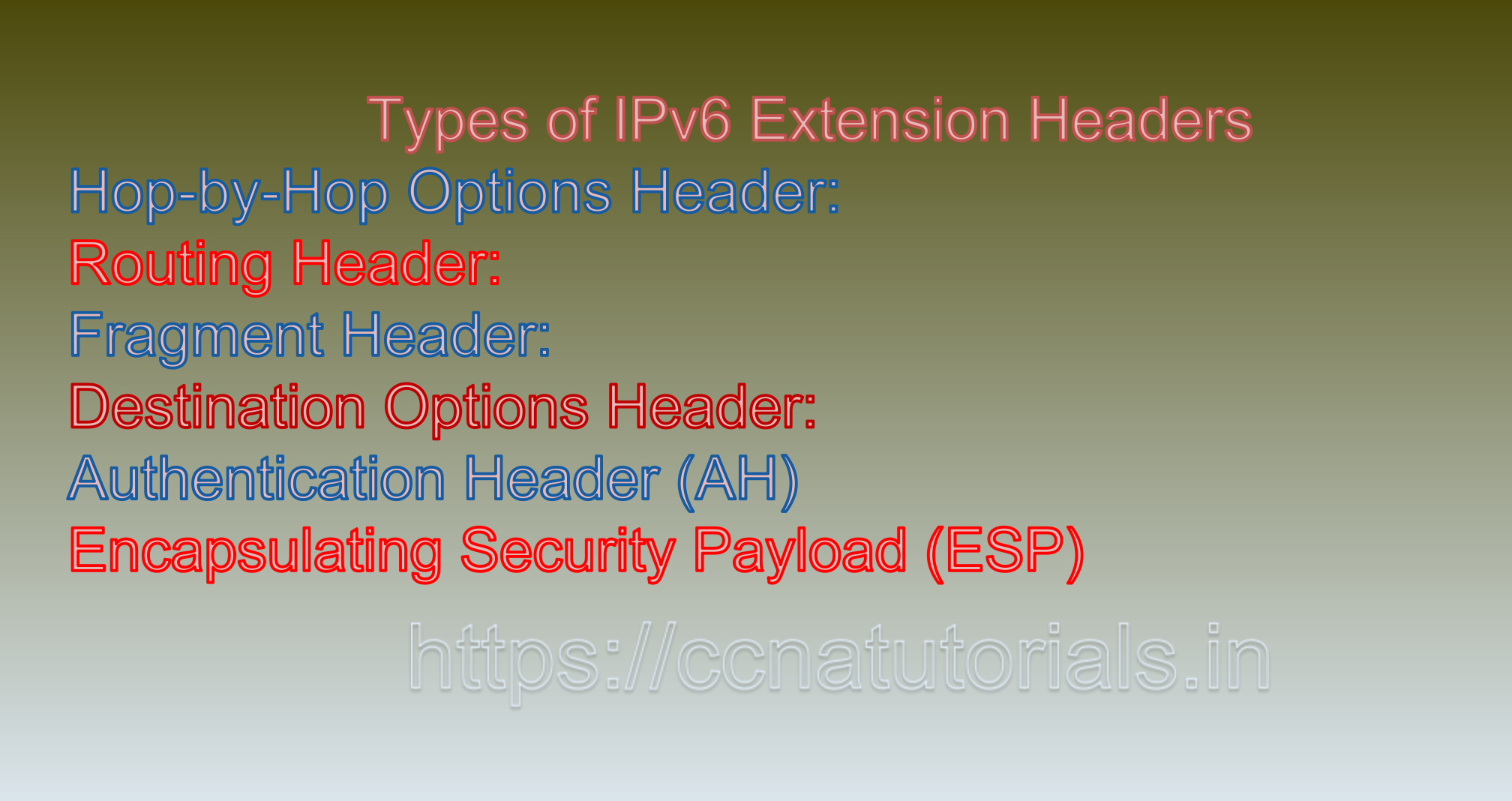Contents of this article
In this article, I describe the IPv6 Extension Headers: Enriching Data Packets with Flexibility and Functionality In the evolving landscape of networking, IPv6 extension headers play a pivotal role in enhancing the capabilities of data packets. The IPv6 Extension Headers extend the basic IPv6 header, providing a modular and extensible framework to accommodate specialized functionalities, optimize routing, and meet diverse networking requirements. In this exploration, we delve into the world of IPv6 extension headers, unraveling their types, purposes, and the advantages they bring to modern communication.
IPv6 Extension Headers: Building Blocks of IPv6 Packets:
While the core IPv6 header is vital for packet routing and forwarding, it lacks the flexibility to address a multitude of specific use cases and advanced features. Extension headers step in to fill this gap by introducing additional layers of information that can be included within an IPv6 packet. Unlike the fixed structure of the main header, extension headers are optional and can be added as needed, creating a dynamic and adaptable packet structure.
Types of IPv6 Extension Headers:
IPv6 supports several types of extension headers, each serving a distinct purpose and adding specific functionalities to the packet. Let’s explore the common extension headers and their roles:
1. Hop-by-Hop Options Header:
The Hop-by-Hop Options Header (HbH) is examined by every router along the packet’s path, ensuring that specific options are applied to the packet as it traverses each hop. HbH options can include parameters related to network management, quality of service (QoS), and packet handling. This header is particularly useful for delivering specialized treatments to packets as they move through the network.
2. Routing Header:
The Routing Header (RH) defines a list of intermediate destinations that the packet must visit before reaching its final destination. This is useful for scenarios where source routing is desirable or when packets need to be routed through specific segments of the network. RH can facilitate efficient traffic engineering and load balancing.
3. Fragment Header:
In situations where packets are larger than the maximum transmission unit (MTU) of a network link, the Fragment Header ensures proper fragmentation and reassembly. This header allows a packet to be split into smaller fragments that can be transmitted across the network and then reassembled at the destination.
4. Destination Options Header:
The Destination Options Header (DOH) provides additional options that are examined only by the final destination node. Similar to HbH options, DOH options offer a way to convey specific requirements or treatments for the packet’s destination.
5. Authentication Header (AH) and Encapsulating Security Payload (ESP):
AH and ESP extension headers cater to security needs. The Authentication Header provides data integrity, authenticity, and replay protection, while the Encapsulating Security Payload ensures confidentiality, data integrity, and anti-replay protection through encryption.
Advantages and Applications of IPv6 Extension Headers:
IPv6 extension headers bring numerous advantages to networking, enabling tailored solutions for various scenarios. Following are some
1. Optimized Routing and Forwarding:
Extension headers allow for efficient routing and forwarding by providing granular control over packet handling at different stages of the network. This can lead to improved performance, reduced latency, and optimized resource utilization.
2. Modularity and Extensibility:
The modular nature of extension headers enables the integration of new features and functionalities without altering the core IPv6 header. This flexibility future-proofs networks and supports evolving requirements.
3. Enhanced Quality of Service (QoS):
Extension headers, such as Hop-by-Hop Options Header, can carry QoS-related parameters, allowing routers to prioritize or treat specific packets differently based on their designated QoS levels.
4. Security:
Headers like AH and ESP provide robust security mechanisms, ensuring data integrity, authenticity, confidentiality, and protection against replay attacks. These features are crucial for safeguarding sensitive information over the network.
5. Traffic Engineering and Load Balancing:
Routing Header empowers traffic engineering and load balancing strategies, enabling efficient distribution of traffic across different network paths.
Practical Use Cases of IPv6 Extension Headers:
Let’s explore a couple of practical use cases to illustrate the application of IPv6 extension headers:
1. Quality of Service (QoS) Differentiation:
In a multimedia streaming scenario, extension headers can be utilized to differentiate packets based on their QoS requirements. A Hop-by-Hop Options Header can carry QoS tags, allowing routers to prioritize video packets over standard data packets. This ensures smoother playback and a superior user experience for multimedia applications.
2. Mobile Network Handover:
In a mobile network, when a device transitions from one access point to another, the Routing Header can specify the optimal route for packets as they move from the old access point to the new one. This minimizes latency and ensures a seamless handover experience for users.

Conclusion for IPv6 Extension Headers:
IPv6 extension headers unlock a realm of possibilities in modern networking, offering flexibility, adaptability, and advanced functionalities to data packets. These headers enrich the IPv6 protocol by enabling specialized treatments, optimized routing, and robust security mechanisms. As networks continue to evolve and diversify, IPv6 extension headers stand as a testament to the innovation and adaptability of networking protocols, shaping the way data is communicated, secured, and managed across the ever-expanding digital landscape.
Examples of IPv6 Extension Headers
IPv6 extension headers are a fundamental aspect of the IPv6 protocol that enable the insertion of additional information and functionalities into data packets beyond the standard IPv6 header. These extension headers offer a modular and flexible framework to accommodate various networking requirements, optimize routing, and ensure secure and efficient data transmission. Let’s explore IPv6 extension headers through practical examples to understand their roles and applications.
Example 1: Hop-by-Hop Options Header (HbH)
The Hop-by-Hop Options Header (HbH) is inserted immediately after the IPv6 main header and provides options that must be examined by every router along the packet’s path. It allows for specialized treatments and configurations as the packet traverses the network.
Suppose you have a scenario where certain packets need to be treated with higher priority to ensure low latency. You can use the HbH extension header to include Quality of Service (QoS) information:
plaintext
IPv6 Header | HbH Options Header | Upper-Layer Header | Data
Example 2: Routing Header (RH)
The Routing Header (RH) allows the sender to specify a list of intermediate destinations that the packet must visit on its way to the final destination. This can be particularly useful for load balancing or ensuring packets take specific paths through the network.
Consider a situation where a mobile device is moving between different access points in a wireless network. The RH extension header can guide the packet through a specific path that ensures seamless handover and minimizes latency:
plaintext
IPv6 Header | RH | Upper-Layer Header | Data
Example 3: Fragment Header
The Fragment Header is used when a packet is larger than the Maximum Transmission Unit (MTU) of a network link. It allows the packet to be divided into smaller fragments that can be transmitted separately and reassembled at the destination.
Imagine you have a video streaming application where large packets need to be transmitted over a network with a smaller MTU. The Fragment Header can be utilized to split the video packets into smaller fragments, ensuring each fragment fits within the MTU:
plaintext
IPv6 Header | Fragment Header | Upper-Layer Header | Data (Fragment 1)
IPv6 Header | Fragment Header | Data (Fragment 2)
IPv6 Header | Fragment Header | Data (Fragment 3)
Example 4: Authentication Header (AH) and Encapsulating Security Payload (ESP)
The AH and ESP extension headers provide security mechanisms to protect data integrity, authenticity, confidentiality, and anti-replay protection.
Suppose you’re sending sensitive financial data over the network. To ensure the confidentiality and integrity of the data, you can use the ESP extension header to encrypt and authenticate the data payload:
plaintext
IPv6 Header | ESP | Upper-Layer Header | Encrypted Data
Advantages of IPv6 Extension Headers:
1. Flexibility: Extension headers allow for the integration of specialized functionalities without altering the core IPv6 header, making the protocol adaptable to various networking needs.
2. Optimized Routing: Routing Header facilitates efficient traffic engineering, load balancing, and seamless handover in mobile networks.
3. Security: AH and ESP extension headers provide strong security mechanisms to protect data during transmission.
4. Resource Efficiency: Fragment Header ensures efficient use of network resources by allowing packets to be fragmented and reassembled only when necessary.
Challenges and Considerations:
While IPv6 extension headers offer numerous benefits, they can also introduce complexity to packet processing and increase the risk of security vulnerabilities if not properly managed. Network administrators need to carefully design, configure, and secure extension headers based on the specific requirements of their network.
Final Conclusion for IPv6 Extension Headers:
IPv6 extension headers play a vital role in extending the capabilities of the IPv6 protocol, allowing for specialized treatments, efficient routing, secure data transmission, and more. By incorporating extension headers strategically, network engineers can optimize their networks, enhance security, and tailor data packets to meet the demands of modern networking scenarios. Understanding and effectively utilizing IPv6 extension headers are essential skills for network professionals as they navigate the complexities of today’s interconnected and ever-evolving digital landscape.






